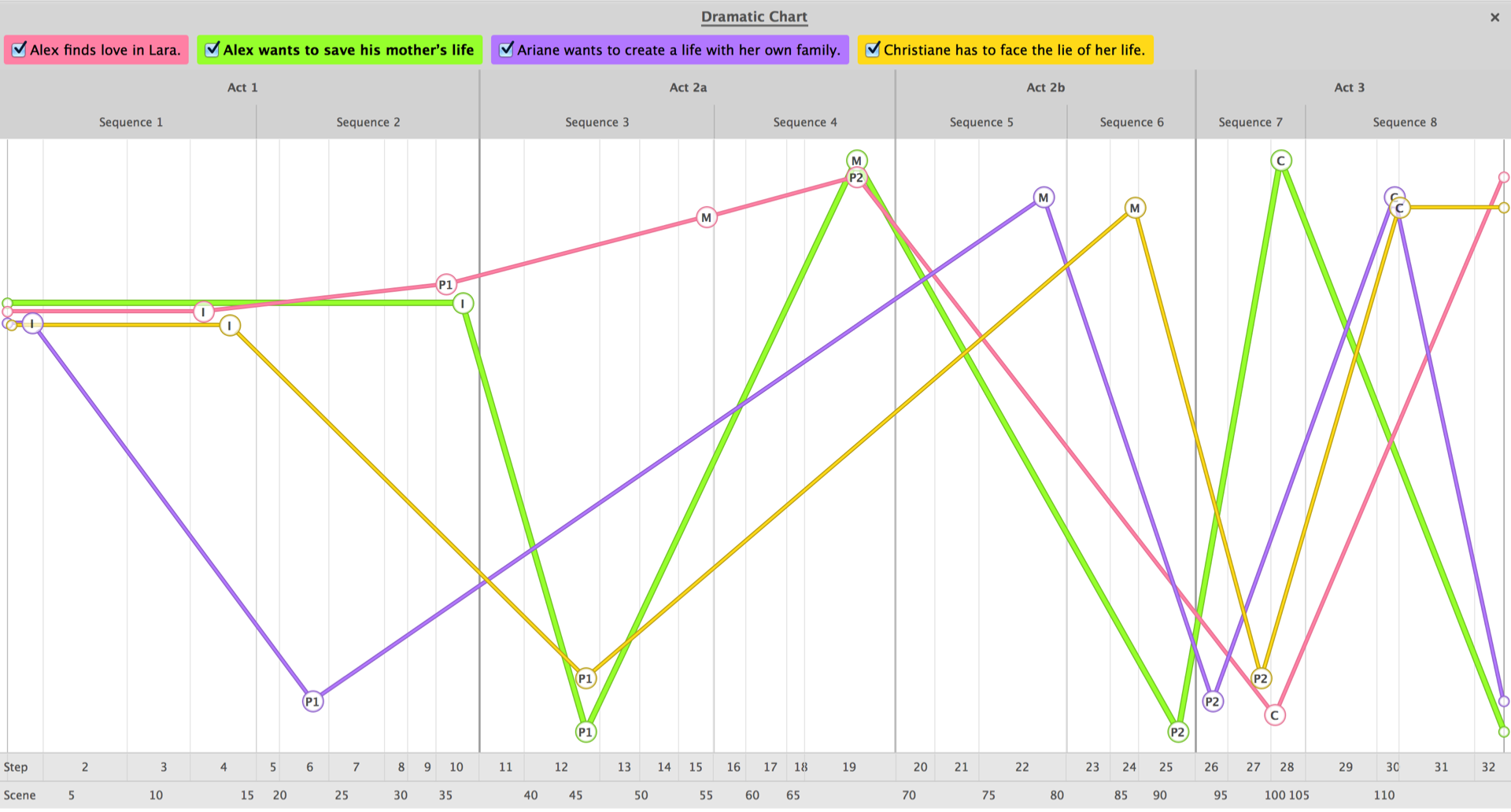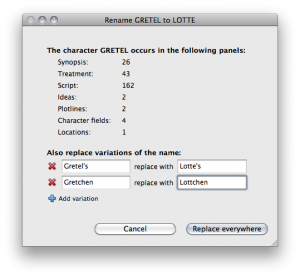Our goal is to make DramaQueen run intuitively so that the writer doesn’t even notice many of its features. Several DramaQueen features don’t even have a button but run invisibly under the surface. Our latest feature the automatic character recognition is a good example of that.
Automatic character recognition
What does ‚DramaQueen automatically recognises characters as well as their gender and age’ actually mean? First of all DramaQueen has to figure out which words actually signify characters: DramaQueen looks for the first appearance of characters in the synopsis, treatment and script. Why? Because a character appearing for the first time is written in all-caps – as the convention goes. With a script DramaQueen also looks for characters having lines of dialogue because they start with their own kind of paragraph spacing.
After DramaQueen has found a character it checks whether there’s a number in brackets directly after the name. If that’s the case the number is put down as the character’s age in the character list.
Afterwards DramaQueen checks the character’s name against a very comprehensive database of first names – separated into female and male. Should the list contain the given name DramaQueen will assign the gender appropriately and record it in the character-panel.
So far, so good. The next step is about not just recognises the character for the first time but to detect all their appearances. This way the outline-panel is able to list exactly which character appears in each single scene. For this to work DramaQueen needs to be able to match all versions of the character’s name: the full name of a character when they first appear (e.g. ‘JANE SMITH’) and the name used for any further appearance (‘Jane’). Unfortunately, it’s a bit more complicated… Not every first part of the name is a first name and not every second part of the name is the family name. Characters can be called ‘Ms. Smith’, ‘Sister Jane’ or ‘Female Police Officer 1’. That’s why DramaQueen contains another key-word list with titles and official titles (e.g. ‘Father’, ‘Princess’, ‘Professor’ etc.) so that DramaQueen can figure out that ‘Inspector James Miller’ is not ‘Inspector James’, but ‘Inspector Miller’.
But what happens when the writer decides to rename ‘James’ and call him ‘Jonathan’? Then it is DramaQueen’s aspiration to not only change the name in the character-panel or in the script but everywhere the character appears within the DQ-file – all text-levels and all panels.
As if that weren’t enough: DramaQueen even makes it possible to substitute all possible name variations (e.g. nicknames) and already suggests the grammatically correct possessive form (e.g. “Alexis’, “Joyce’).
All these processes – the constant searching, finding, matching, transferring, correcting etc. – are optimised in a way that DramaQueen manages them in real-time – second by second. The writer doesn’t need to press any synchronising-button because the character recognition always runs synchronously.
Smart-Import
Another example for DramaQueen’s ‘deeper levels‘ is the smart-import service for scripts which is much more than a simple import. In reality our importer analyses the outer form of the script and obtains all kinds of further information contained in the imported script: all single scenes are gathered and listed, as well as all characters (along with their age and gender). It also gathers all information contained in scene headings: location, interior or exterior setting, time of day. Again the importer doesn’t just transfer the text but interprets it: regardless of whether the time of day is ‘EARLY IN THE MORNING’, ‘MID-DAY’ OR ‘LATE AFTERNOON’ DramaQueen will extract the significant information – meaning that this scene takes plays during day light. All ‘DAY’ scenes are marked with a sun-icon while all ‘NIGHT’ scenes get a moon and all ‘DUSK’ and ‘DAWN’ scenes receive a setting/rising sun. This way the outline-panel offers a quick overview of all scenes and their times of day as well as the alternation between different times. (By the way: the smart-import is managed within seconds as well).
Automatic storyline recognition
It gets even more convenient when single DramaQueen tools work in unison. Because when we combine and mesh both features – the automatic character recognition and the smart-import – DramaQueen will be able to automatically detect single storylines in the script during its import. This is possible because every storyline tells the story between particular characters. And when it is known which characters interact in each scene the deduction of scene-storyline-affiliation is no longer a problem!
That’s the theory… In practice we will find that the implementation of this feature – coming up in our next update – won’t be that straight forward and that we’ll have to consider and deal with a bunch of special use-cases. But don’t worry – we’ll make sure to come up with very ‘intuitive’ solutions.


 DramaQueen visualizes the architecture of your story. But what kind of information can you gain from the graphic display? Use these questions to check the narrative arcs of your storyline:
DramaQueen visualizes the architecture of your story. But what kind of information can you gain from the graphic display? Use these questions to check the narrative arcs of your storyline:




